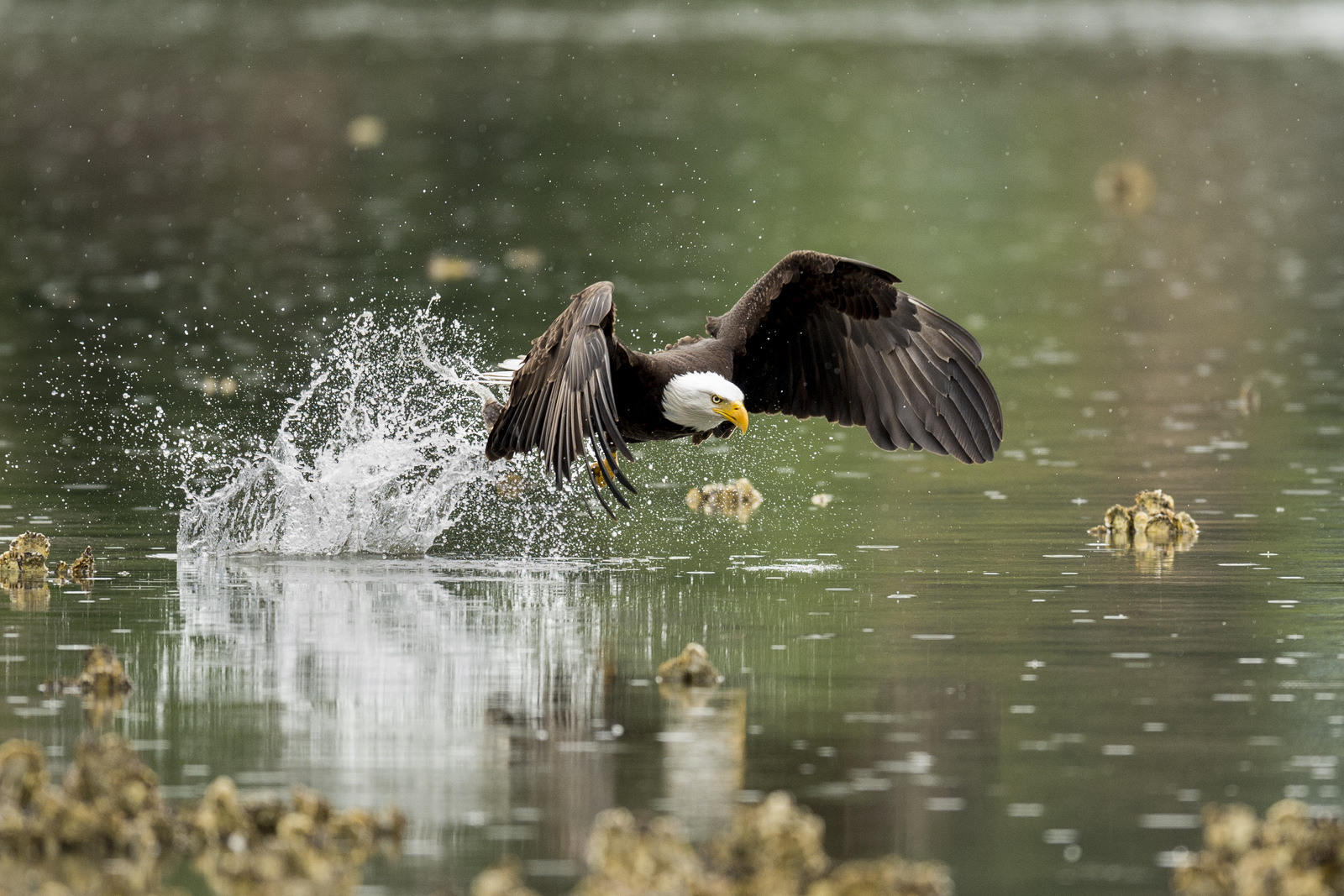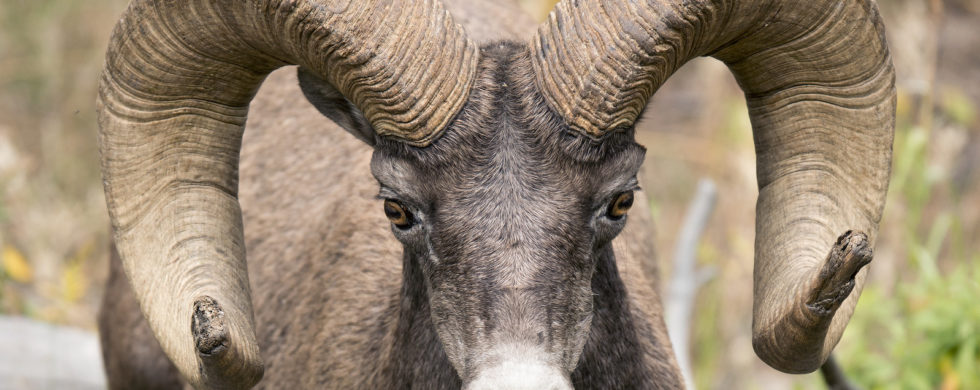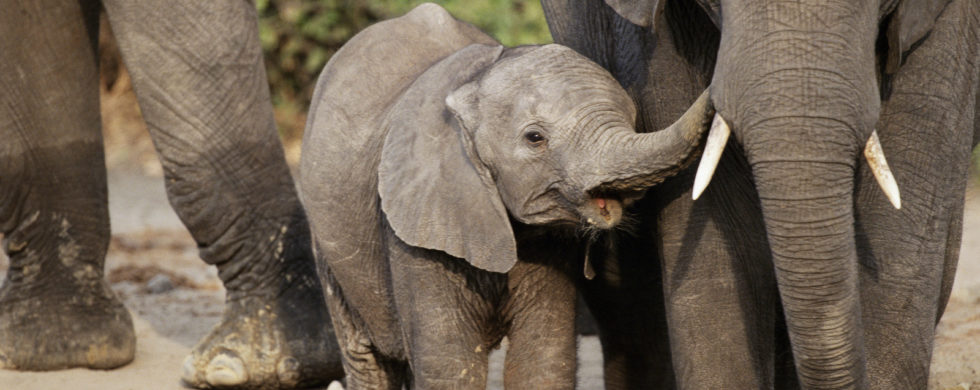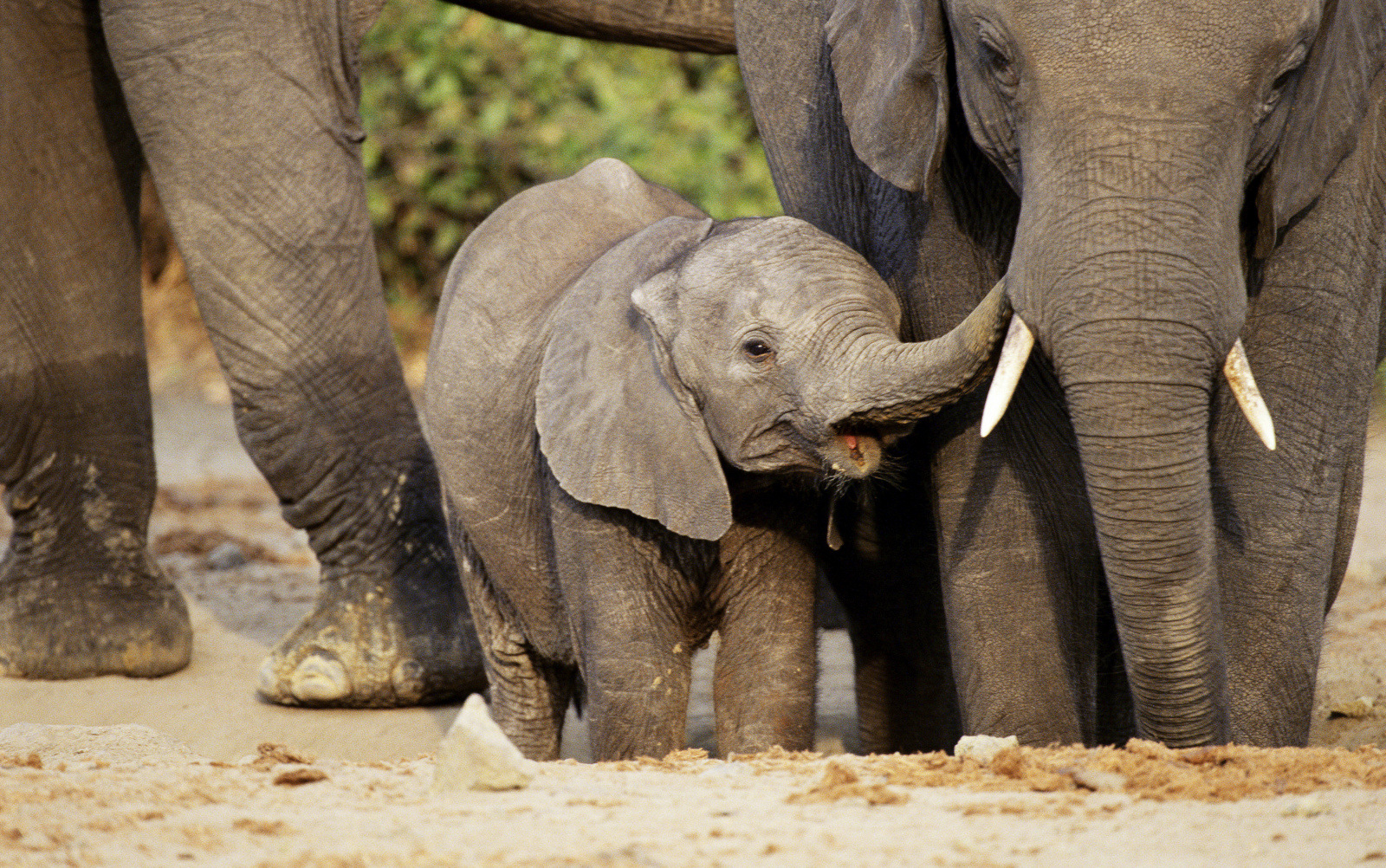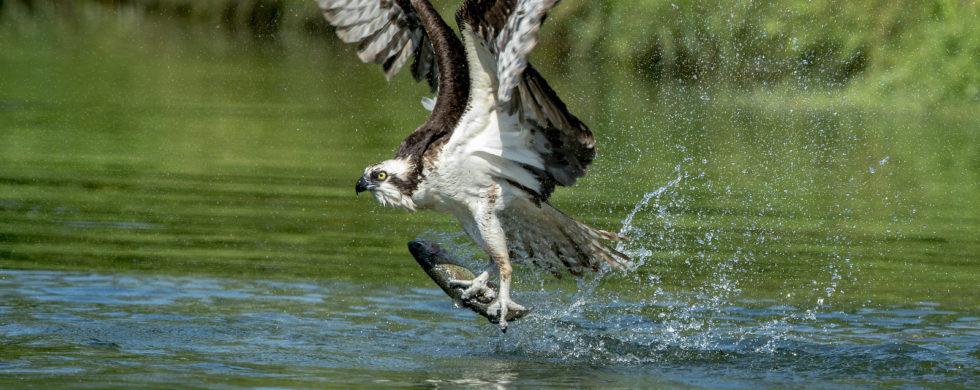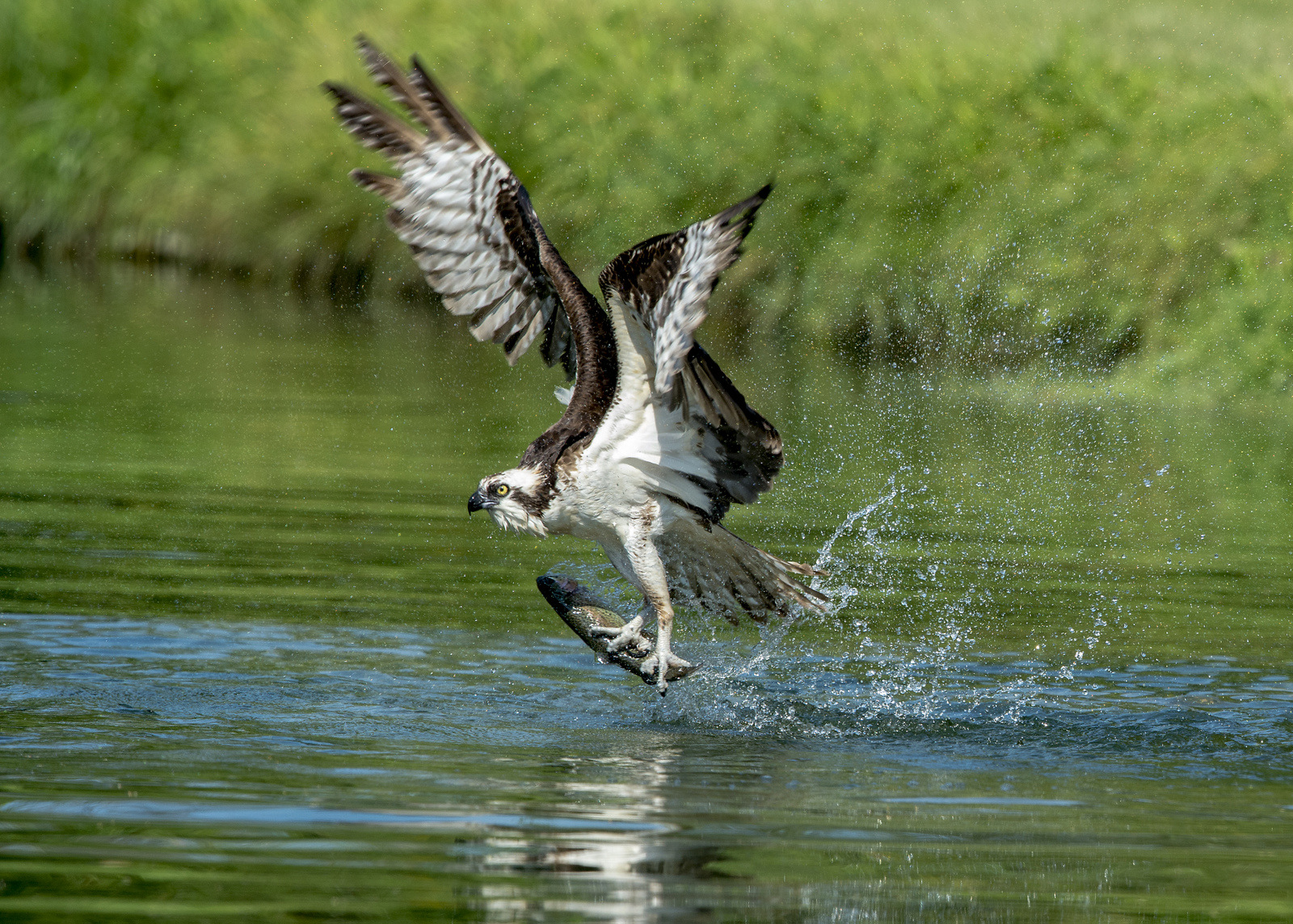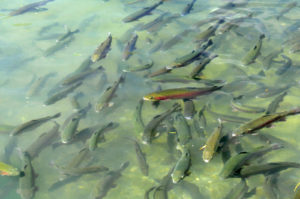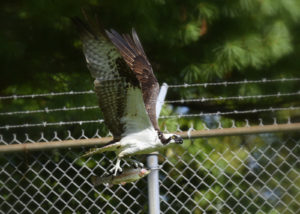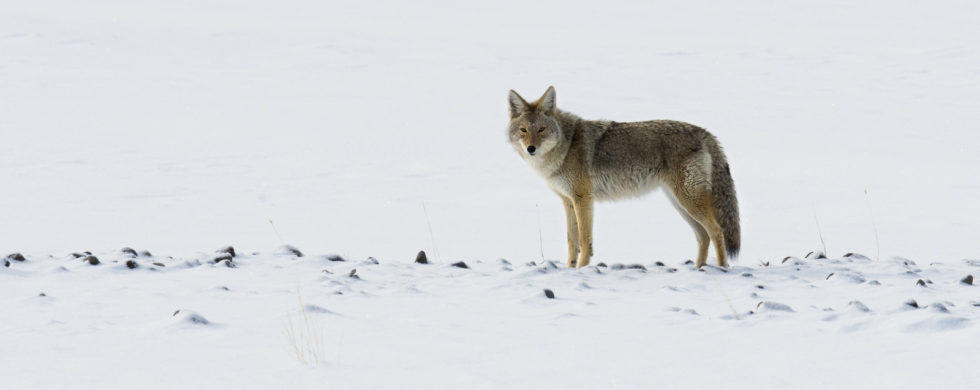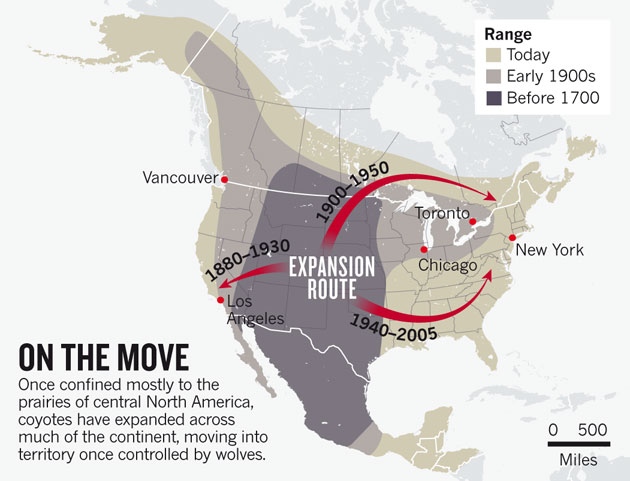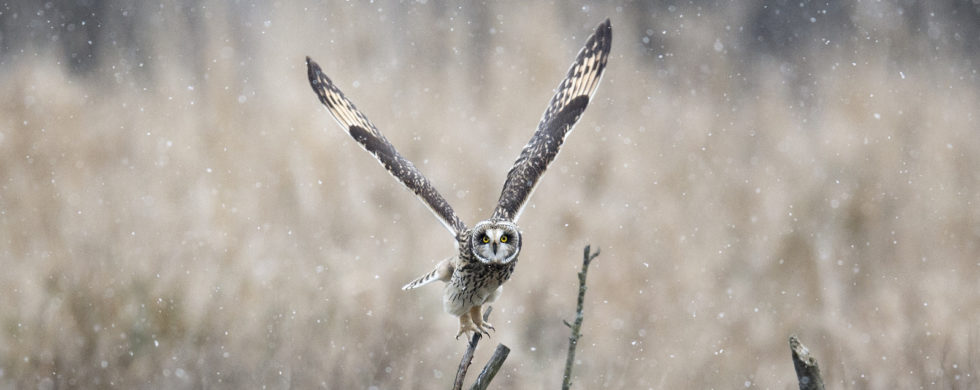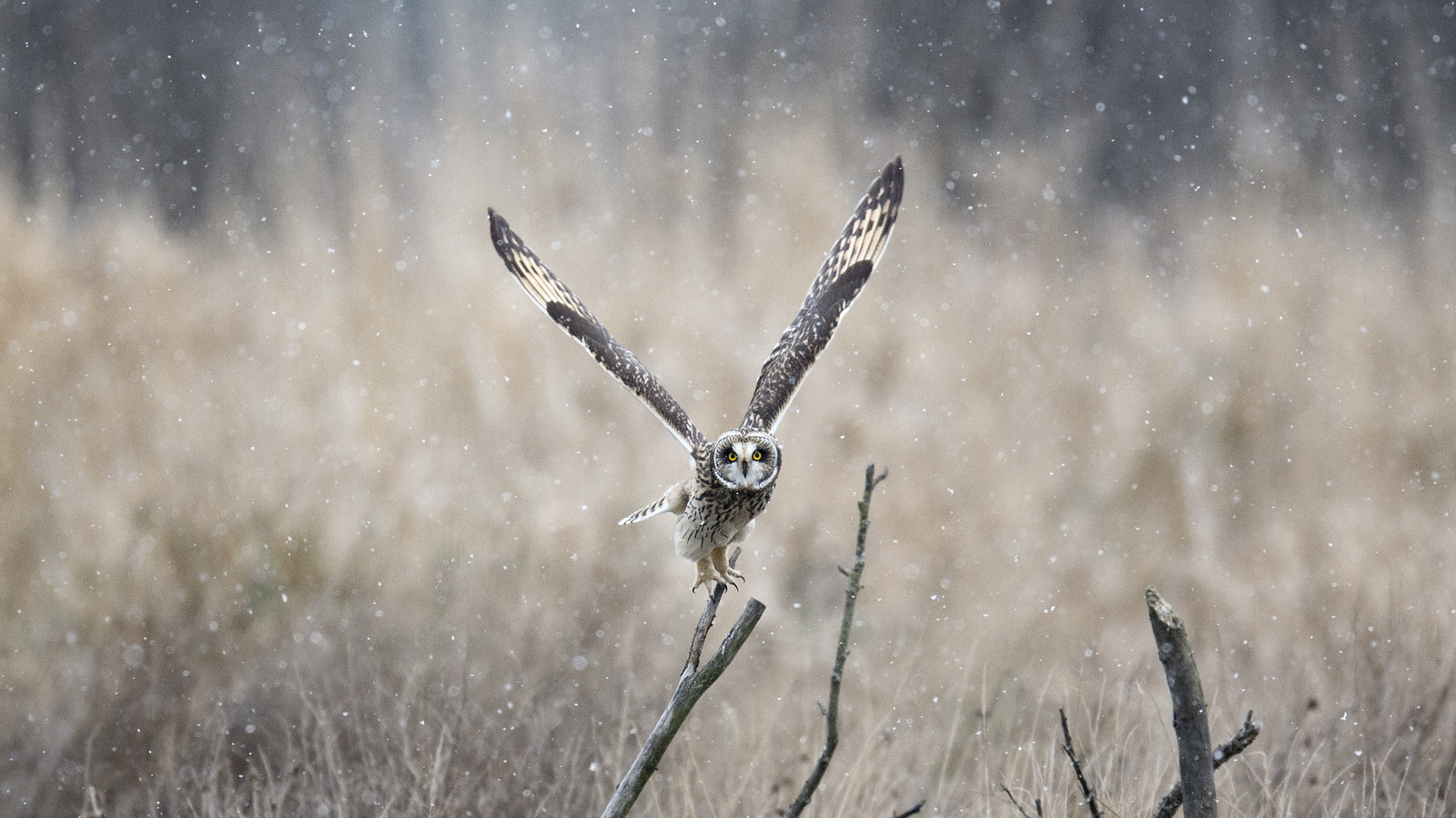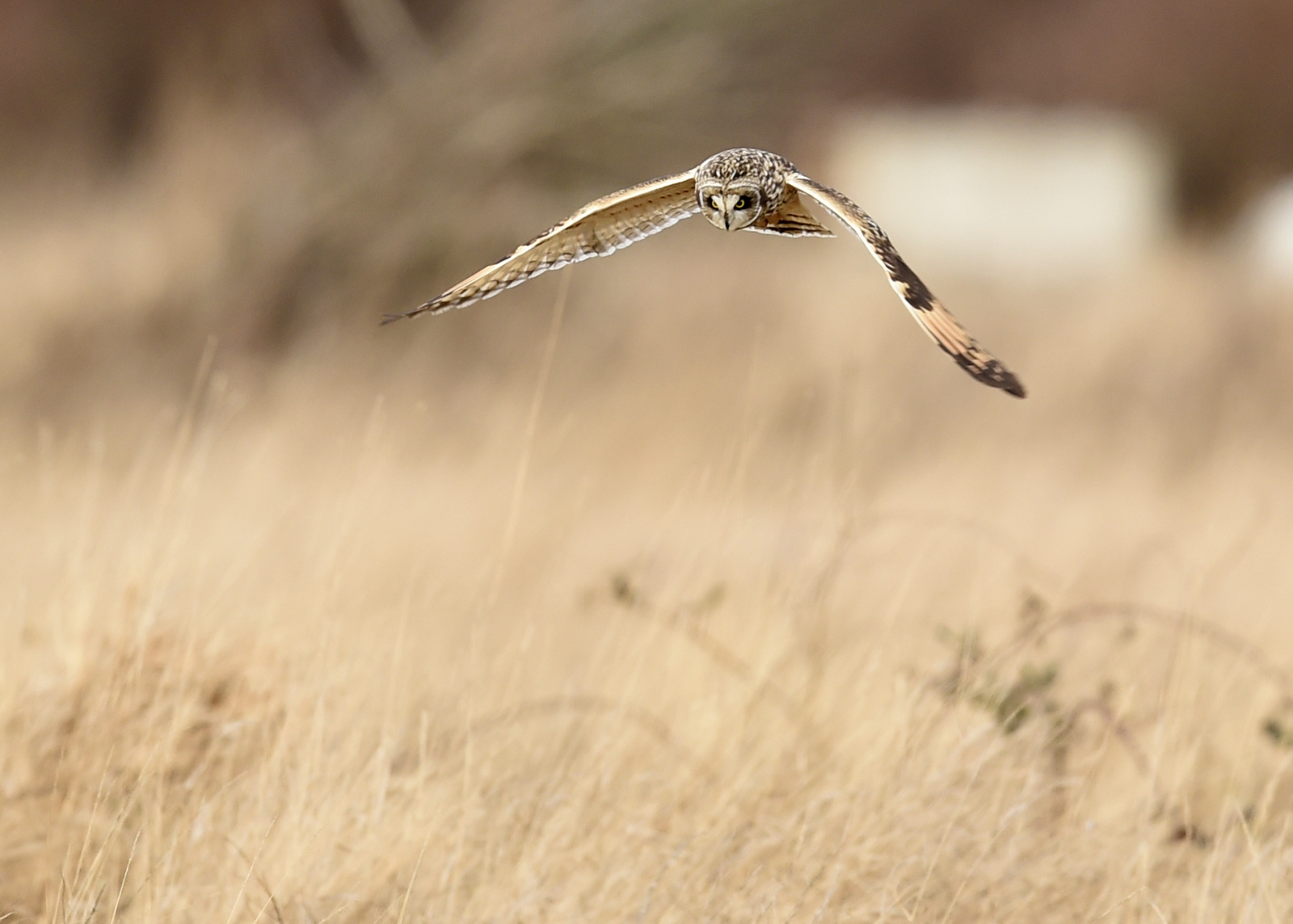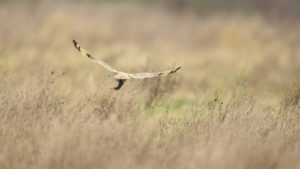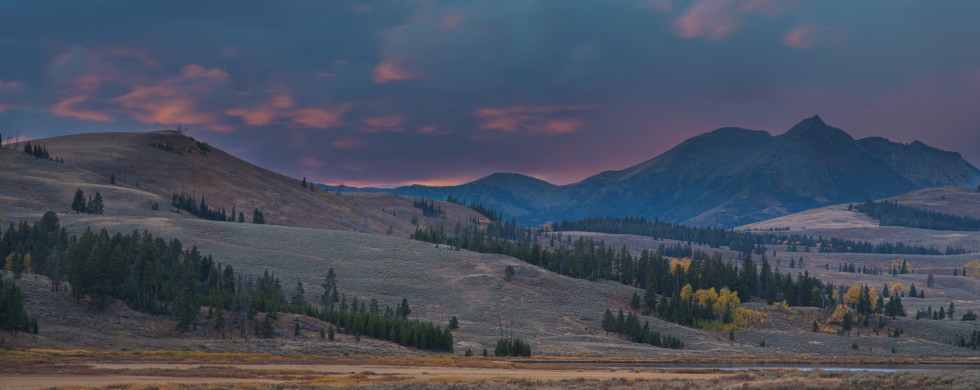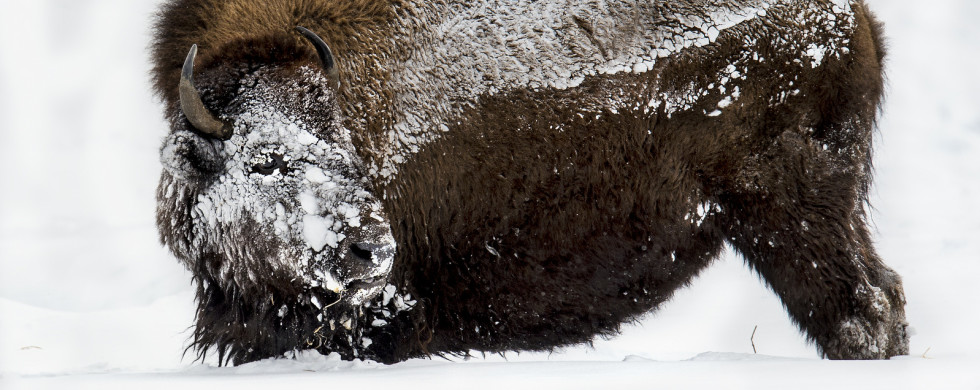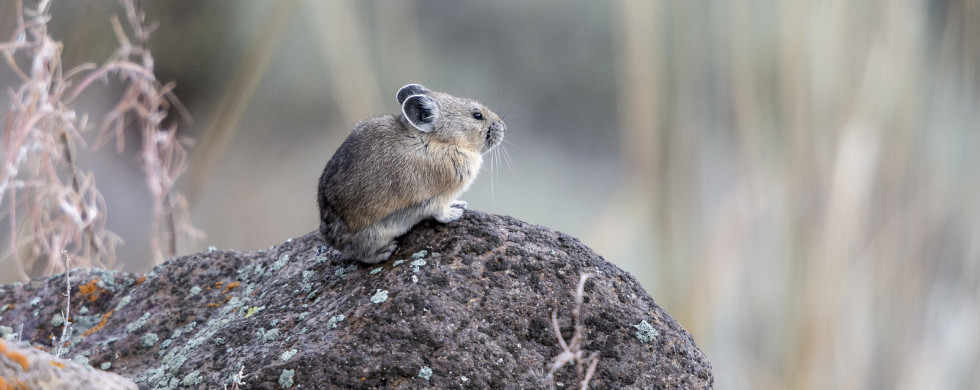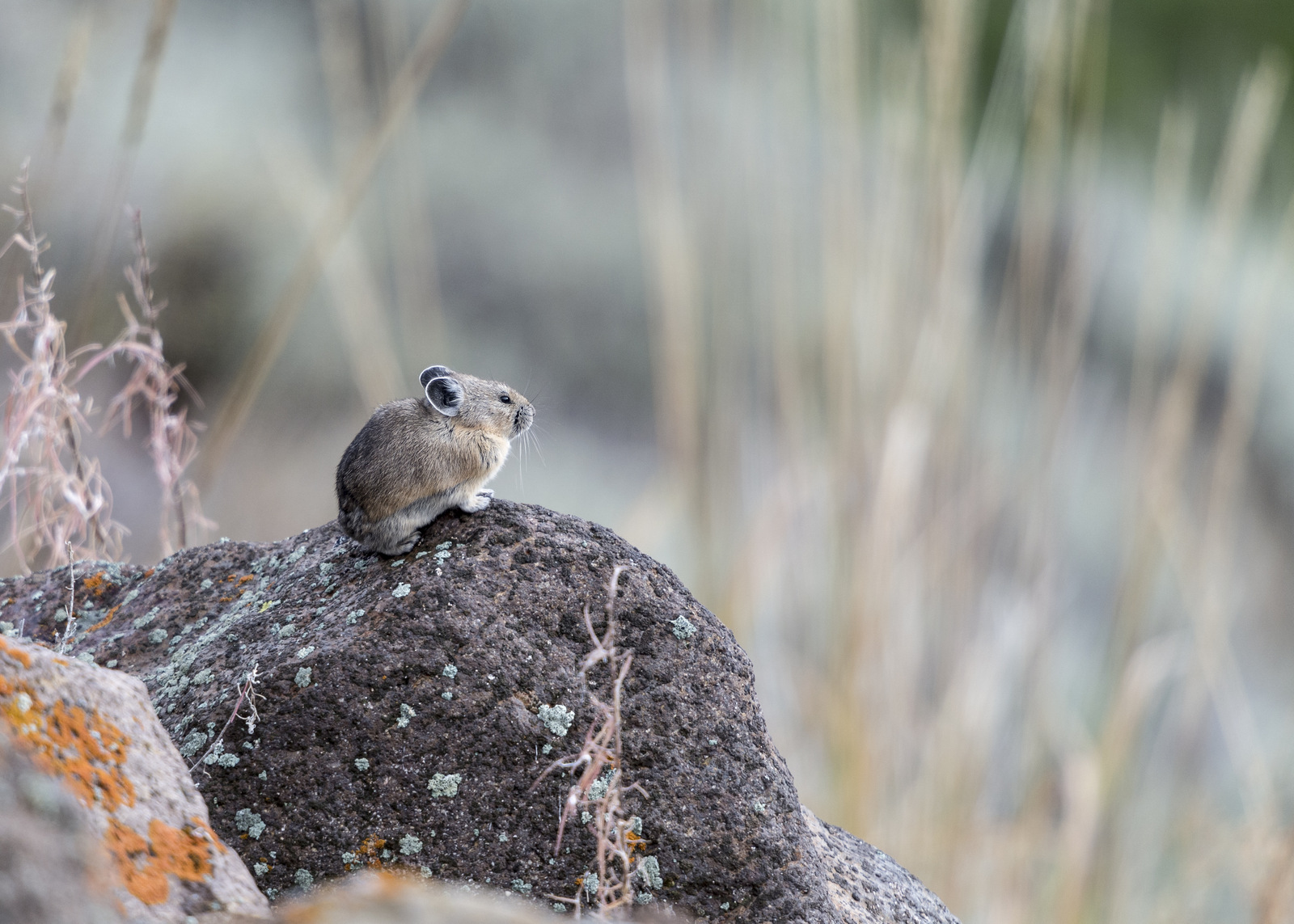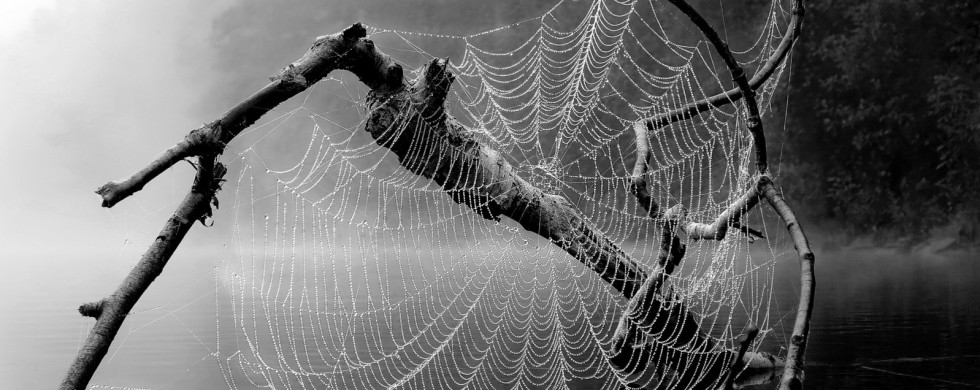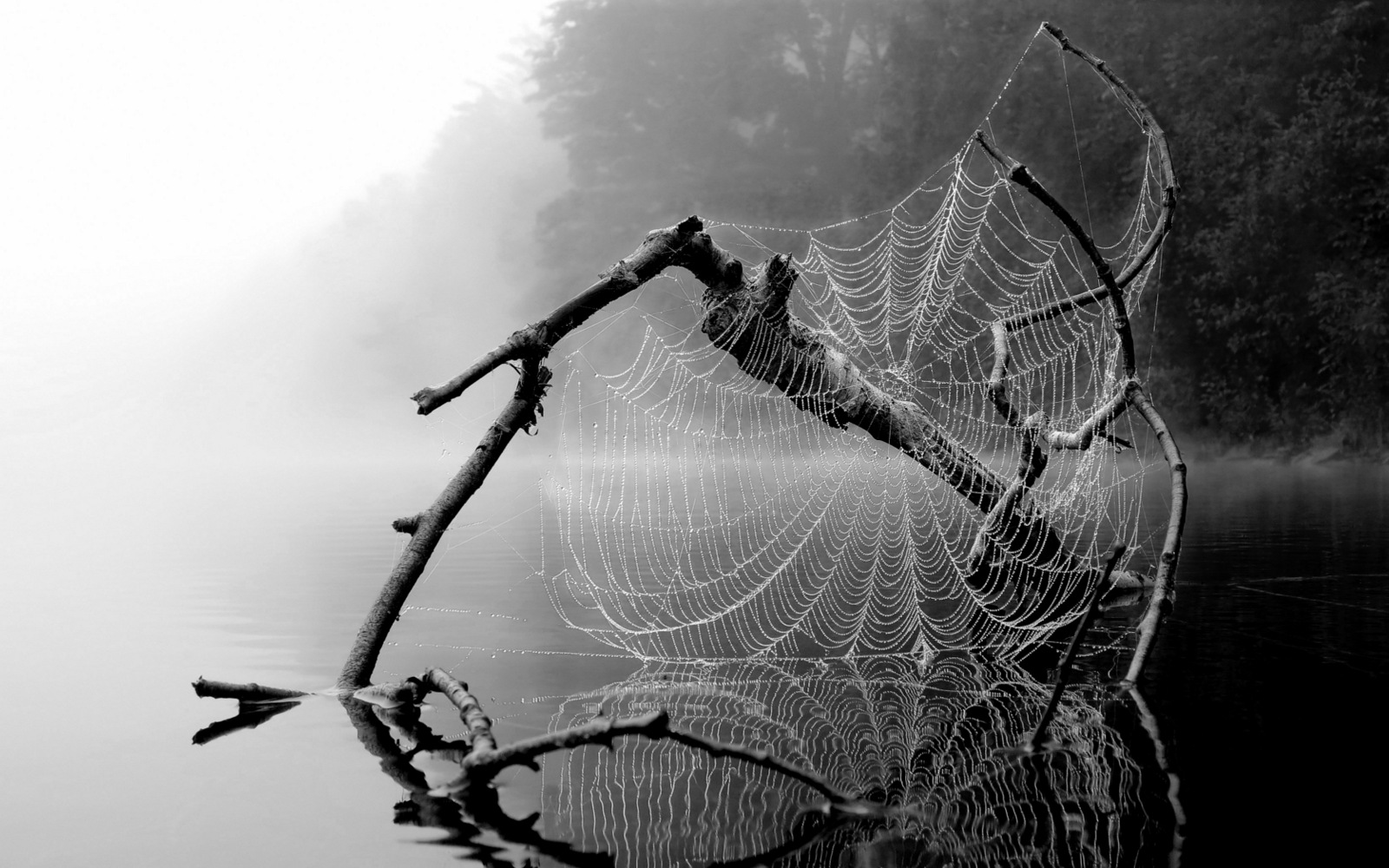19
31
Shot of the Month – May 2017
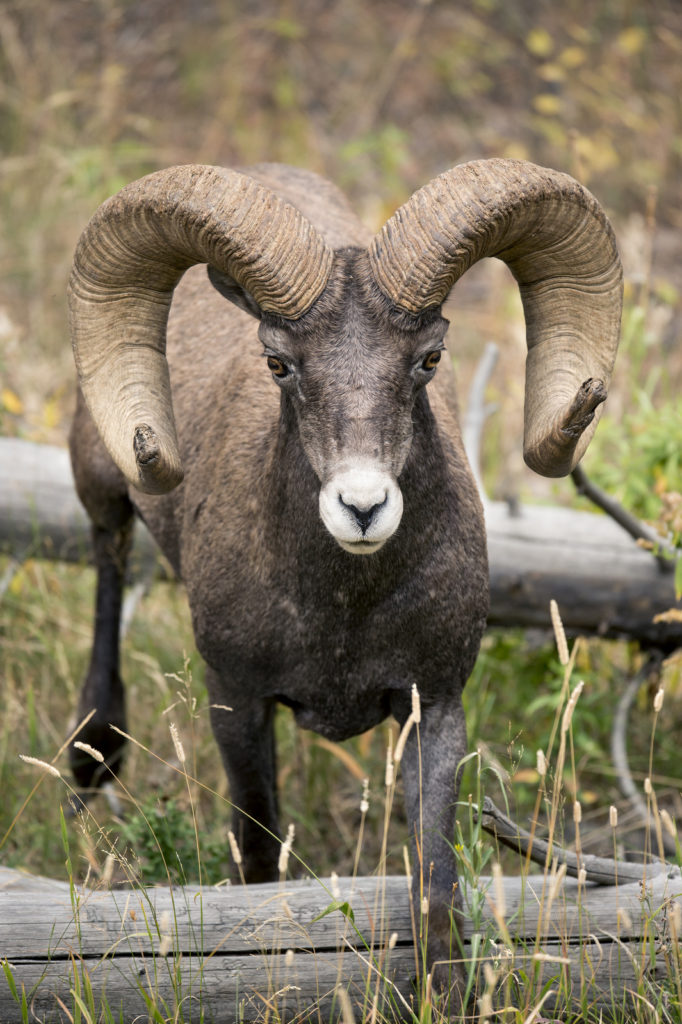 This month we visit with a ram that fully embraces his name – the Bighorn Sheep (BHS). We found this big fella in Yellowstone National Park and our guide mentioned that this was one the largest set of horns he had seen in 30 years of visiting the park.
This month we visit with a ram that fully embraces his name – the Bighorn Sheep (BHS). We found this big fella in Yellowstone National Park and our guide mentioned that this was one the largest set of horns he had seen in 30 years of visiting the park.
As I discussed in a previous post, “Bighorn Sheep” is a rather chauvinistic name for the species as the females also have horns, though they are not nearly as big, nor curved. The lads get all the attention, a-gain.
These rams definitely know that they are impressive — this one walked by me with his shoulders back, chest out and his head raised, as if saying, “Yes, soak it in, I am magnificent.”
Those horns can weigh 30 pounds, equal to the weight of all the other bones in the ram’s body. A ram can weigh 174 to 319 pounds so those horns can make up about 10% of their total body weight.
Mature males spend most of the year as part of a bachelor flock. Ahhh, those were the days…
The rams join the female groups in November when the mating season begins. The BHS rams are most famous for their epic head-clashing battles to win the right to mate with the females.
These fellows will smash their heads together as they hurl themselves at each other at 20 mph — generating about 800 pounds of force – sixty times more force than needed to kill a human. The rams can survive these violent collisions because their skulls have two layers of bones above the brain that act as shock absorbers. The sound of these collisions can be heard from a mile away.
These battles can last for 24 hours until one sheep decides that he has had enough and simply walks away. Wait, that’s it??!! I expected a denouement with a bit more operatic panache given the fury and scale of the spectacle.
Oh well. The clash of the Mountain Titans ends with a quiet, “I’m out.” I suppose that there is a certain civility in that.
You can catch the mind-numbing show here. (I wasn’t able to embed the video)
The prelude to the fight can be seen below (very nice footage).
In case you were wondering, the title of this post is a nod to Bam Bam Rubble…an adorable character from my youth who seems to capture the simple essence of a bighorn ram’s approach to life…
Until next month…m
Nikon D4S, Nikon 600mm f/4, 1/800 sec, ISO 800, +0.5 EV
30
Shot of the Month – April 2017
Another shot for the “Awwwl” Collection. For those of you not keeping score at home, this collection includes huddling hyraxes, a burrowing owl, loon chicks with mom, and a pika. This image is a favorite among moms everywhere and is one of my most popular cards. I photographed this adorable baby elephant in Botswana.
Female elephants live their entire lives as part of a tightly-knit family group. Life in the herd revolves around breeding and the raising of calves. A new calf is typically the center of attention for all herd members. The little one photographed above must be pretty new — it is so small that it could easily walk under the elephant behind it.
Females are ready to breed at the age of thirteen and will give birth after a 22-month pregnancy. At birth, all of the other elephants will gather around the newborn to touch and caress it with their trunks. In the video below you can see a herd’s reaction to a newborn.
Soon after birth, the mother will select several full-time baby sitters or “allomothers” from her group. These allomothers will help in all aspects of raising the calf. The more allomothers a baby has the more free time the mother has to feed herself and produce nutritious milk, increasing the chances of survival for the calf. The allomothers also benefit by gaining experience on how to raise a calf which makes them better mothers when they are finally ready to breed.
Here you can see a whole herd come together to help a baby elephant that is stuck in a water hole:
Given all that love and protection, baby elephants seem free to enjoy life. I have watched them play in rivers and they are just like human children at the beach. They run and chase each other. They splash one another and the teenagers knock the smaller ones over – all in good fun. Check out this little guy (the fun starts around 0:35 seconds):
There is an African proverb that says “It takes a village to raise a child.” Gee, I wonder where the inspiration for that may have come from?
Until next month…
31
Shot of the Month – March 2017
Here we see an Osprey doing what it does best — catching a fish. This was one of the first images I ever captured of an osprey in action. I have to confess however that this is not a completely “wild” setting. Let me explain.
A couple of years ago while living in Vermont I heard about ospreys that regularly visited a fish hatchery that was about an hour from where I lived. The hatchery had an assortment of holding tanks that held fish from uber small to quite big. The biggest fish, rainbow trout, in this case, were held in an outdoor pond. For an osprey, this was like shooting the proverbial fish in a barrel.
Initially, the osprey parents would stop by to catch a couple of fish each day to feed themselves and the kids. When the chicks were old enough to fly the parents would bring them to this pond to practice fishing. I heard about the spectacle and spent a couple of weekends sitting by the pond to see what I could catch. It was interesting watching the parents circling above as they called out to their offspring, seeming to implore them to give it a go. It was easy to distinguish the parents from the newbies — the parents would circle briefly and dive in with great confidence and efficiency. The kids, uh, not so much. They would start a dive and then abort. Come in for another try and pull up at the last second as they got close to the water. Eventually, after numerous false starts, they would dive in, occasionally catching a meal.
As for me, I had a grand ole time. I had a front-row seat and could see up close and personal how an osprey earned a living.
Ospreys are true piscivores — fish make up about 99% of their diet. Given their love of fish, osprey nests are usually found within 12 miles of a body of water. They typically fly about 30 to 100 feet above the water surface and use their exceptional eyesight to spot a meal. Osprey tend to prefer shallow bodies of water since it can only plunge about three feet under the water’s surface with its feet-first dives. These hawks are pretty good at what they do and usually catch a fish in 1 out of 4 tries. It takes an experienced adult about 12 minutes of hunting before making a catch.
The osprey’s feet are highly adapted to facilitate holding on to its slippery catch. Osprey can shift one outer toe to the back if needed to better grasp a fish. No other birds of prey can do that. Their feet also have barbed pads on the soles and the talons have backward-facing scales — all adaptions to help maintain a firm grip. To facilitate an efficient flight back to the nest or the preferred dining locale, an osprey will orient the fish headfirst to minimize wind resistance!
As they say, you can teach a man to fish, but he still won’t be as good as an osprey. Or something like that.
Until next month…
Here is a great video showing how osprey hunt:
Nikon D4S, Nikon 600 mm, f/8, 1/2000 s, ISO 800, -0.5 EV
28
Shot of the Month – February 2017
This month we visit with the natural world’s “Unbreakable” star – the coyote. I photographed this fine-looking fellow in Yellowstone NP. For the uninitiated, the film “Unbreakable” is an American film about a man who learns that he has supernatural powers and basically, he can’t be killed. The Coyote, at least as a species, seems to have similar powers. (I recommend the film, if you haven’t seen it)
In the last two hundred years we have done a wonderful job of wiping out many of the continent’s top mammals. Fifty million bison were reduced to about twelve thousand. The grey wolf used to inhabit the entire United States but is now largely extinct from most of the country. The North American cougar was extirpated in the eastern half of the country by the beginning of the 20th century.
And we have been working overtime to kill off the coyote. We kill a coyote every minute in the United States. I’ll repeat that morsel, in case you blinked.
We kill a coyote every minute in the United States. In other words, we kill about 500,000 coyotes each year.
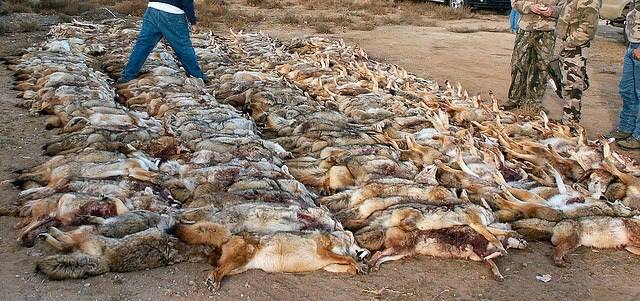
Coyote Killing Contest (Source)
We are very determined to wipe this animal out. In the 1920s the US government created the Eradication Methods Laboratory whose sole job was to kill predators that we didn’t like. Congress passed a bill in 1931 allocating $10 million to the lab to launch a poison campaign. From 1947 to 1965 the agency killed about 7 million coyotes using blanket poisoning, sometimes putting out up to 4 million poison baits at a time. Since the 1970s this job was handed over to the Wildlife Services Agency, which is part of the Department of Interior. Since 2000 the agency has killed 2 million mammals (coyotes, wolves, and cougars) and 15 million birds. More recently the government uses airplanes to shoot about 80,000 coyotes per year on behalf of the livestock industry. Many states have a bounty on coyotes and you can pretty much kill coyotes at will in many places. In some states, they have contests to see who can kill the most coyotes in one day.
Normally, this is the part where I tell you how dire the situation is for the coyote. How they are highly endangered and near extinction. Not this time, my friends. As I mentioned, the coyote is unbreakable.
In fact, the coyote is THRIVING. Never been better, thanks for asking!
How is that possible??!!
The coyote’s superpower is adaptability. They are masters of exploiting the changes in the environment caused by humans. When the settlers arrived coyotes only lived on the western plains but once we killed off the wolves everywhere else the coyotes began to migrate into new territories and they now occupy most of the continent.
Coyotes historically were smaller than wolves and couldn’t compete with them. In the 1800’s the wolf population was at a low density due to human persecution and wolves had a difficult time finding a mate. As coyotes migrated east the wolves took the next best option and mated with their smaller “cousin”. As a result, the northeastern coyote-wolf hybrids were bigger, stronger, and able to kill larger game. This allowed coyotes in the east to be able to kill deer, something their smaller relatives in the west are unable to do.
Coyotes have also moved into urban centers and seem to love life in New York City, Washington D.C., Chicago, and Los Angeles, to name a few of their favorite haunts. Turns out that cities are pretty safe because people are not shooting, trapping, or poisoning them there. The coyotes adapted their diet to eat squirrels, household pets and discarded fast food. In rural America coyotes live for about 2 to 3 years while in the city a coyote can live for 12 to 13 years!
Under normal conditions, coyotes have 5-6 pups in a litter. However, when the coyotes feel persecuted they increase their litter size to 12 to 16 pups. You can kill off 70% of coyotes one year, but by the next summer, their numbers will have recovered. They use howls and yipping to create a kind of census of the coyote population. If their howls are not answered by other packs, it triggers an autogenic response that produces larger litters. (Source)
Coyotes also developed a fission-fissure adaption to help them survive. If life is going well, coyotes will live and hunt in packs. However, if they are persecuted, say by wolves or humans, then coyotes will abandon pack life and scatter across the landscape in singles or pairs. For example, the poison campaign of the 1970s really helped scatter coyotes across the country.
There you have it, another sad tale that makes me embarrassed and ashamed to be a human. But congrats to the coyote for stickin’ it to the man. I’m rooting for ya!
Check out Project Coyote to learn how you can get involved to stop the slaughter of coyotes and MANY other animals.
For more outrage, click here:
National Geographic article on the Wildlife Services Agency
Washington Post article on the Wildlife Services Agency
I got much of my information for this post from these great articles. Highly recommended:
How the Most Hated Animal in America Outwitted Us All (National Geographic article)
Rise of the coyote: The new top dog (Nature Journal article)
Until next month…..
Nikon D500, Nikon 600mm f/4 lens @ f/8, 1/2000 s, ISO 400, EV +0.667
31
Shot of the Month – January 2017
As you may recall from an earlier post, I am a BIG fan of owls so it is an exciting day when I get to add a new owl species to my portfolio. Let me introduce the Short-eared Owl (SEO), as captured here in this lovely winter scene that I found about an hour north of Seattle. Upon moving to Washington State I learned that Short-eared Owls (SEOs) winter over in my new state to escape the cold of northern Canada. Accordingly, I have been spending many a chilly weekend out looking for these aerial acrobats.
Owls can be very hard to photograph as they are usually most active at night. SEOs are one of the easier owls to view, relatively speaking, in that they often hunt during the day. Bless them.
The Short-eared Owl prefers open terrain and can be found in prairies, coastal grasslands, meadows, savannas, tundra, marshes, and other low-vegetation habitats.
These owls specialize in hunting voles and other rodents. The owl usually flies just a few feet off the ground as it scans for a meal — its flight can be highly erratic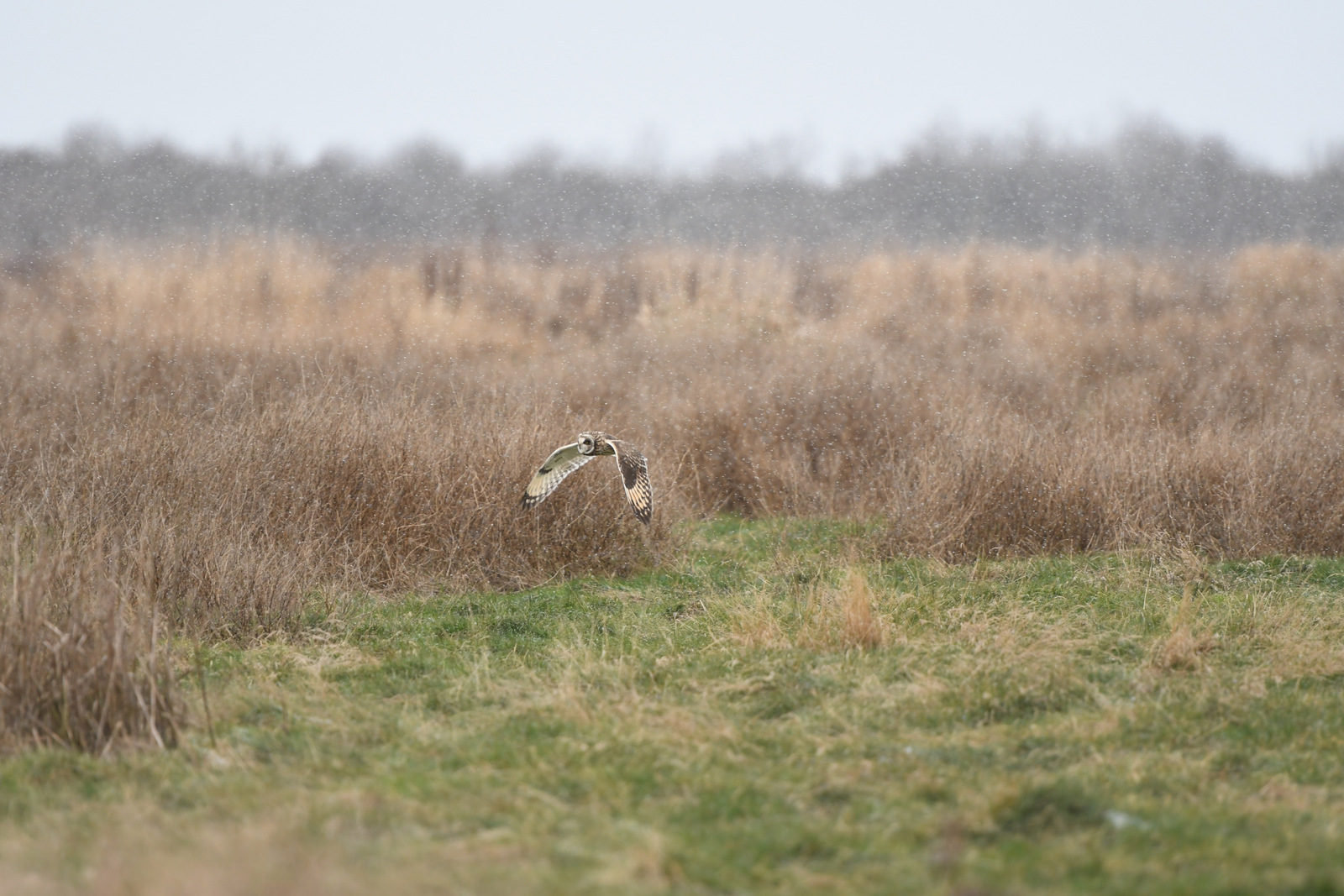
and undulating. As it listens and looks for prey it may suddenly bank to one side or another, or slam on its air brakes to drop to the ground feet first to grab its victim. Sometimes it will hover over a spot as it waits for an opportunity to pounce.
Imagine a large moth flying over a field and you will have a sense of its herky-jerky flying style. As a photographer, I can tell you that trying to capture an image of an SEO in flight is one of the most difficult types of photography I have tried to do. I will be tracking it, tracking it, just about ready to release the shutter, and then, poof, the bird vanishes from the viewfinder. This happens A LOT.
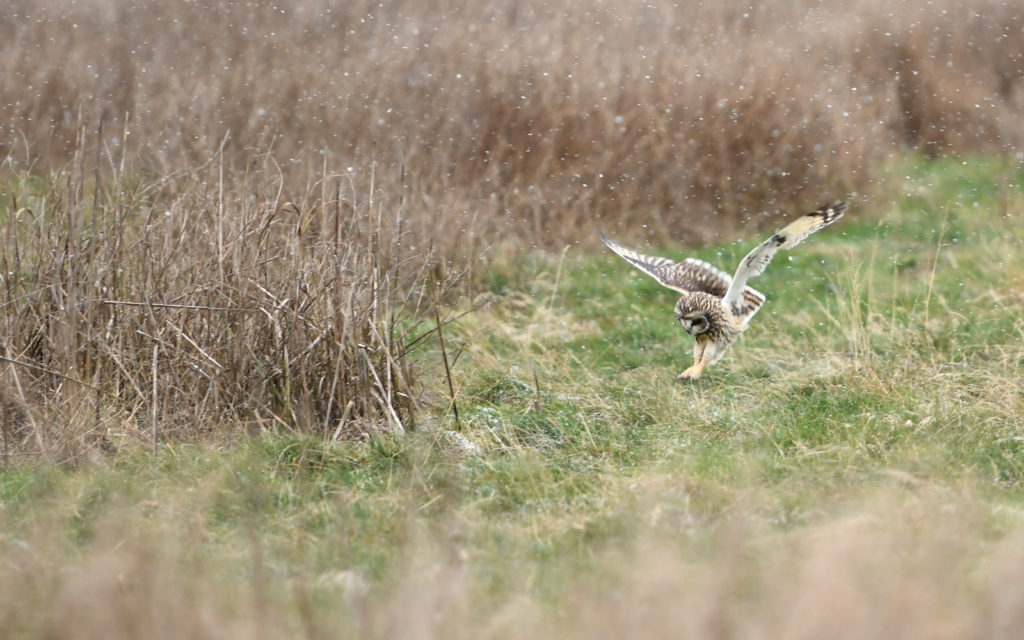 On a typical day, I will arrive at sunrise and take up a position in the field. And then I wait. As the sun rises, and the voles and mice become more active, the SEOs suddenly appear from the ether. I have seen as many as seven SEOs working a large field at the same time. The owls crisscross their way over the terrain in sortie after sortie as they look for prey. It is an amazing scene to behold though it must be a rather terrifying experience if you are a vole.
On a typical day, I will arrive at sunrise and take up a position in the field. And then I wait. As the sun rises, and the voles and mice become more active, the SEOs suddenly appear from the ether. I have seen as many as seven SEOs working a large field at the same time. The owls crisscross their way over the terrain in sortie after sortie as they look for prey. It is an amazing scene to behold though it must be a rather terrifying experience if you are a vole.
The airspace above these fields will soon fall quiet as the owls begin to migrate back north for mating season which starts in March. I imagine that spring can’t come soon enough for the voles — a few months respite from the constant onslaught from those malevolent, murderous moths.
Until next month…
Nikon D4S, Nikon 600mm f/4, 1/1600 s, ISO 1600, +0.5 EV
07
2016 was a year of transition — we moved across the country from Vermont to Seattle, Washington and we (Nicky and I) both took on new jobs. Between moving and career transition I did not have as much time for photography. We did manage to make two trips to Yellowstone NP (once in the Fall, and once in the Winter) while most other photographic forays were weekend trips exploring our new state. Four of my favorite images were shot in Washington while the other six images were shot in Yellowstone. Click on image below to see it bigger (highly recommended).
The Top Ten for 2016:
#1 Bobcat
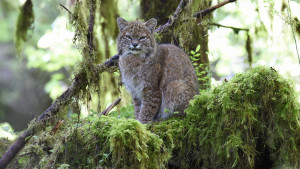 One of my earliest forays in Washington State allowed me to see my first bobcat in the wild and produced this amazing view in the Hoh Rainforest. You can read the full story behind getting the shot here.
One of my earliest forays in Washington State allowed me to see my first bobcat in the wild and produced this amazing view in the Hoh Rainforest. You can read the full story behind getting the shot here.
#2 Marmot
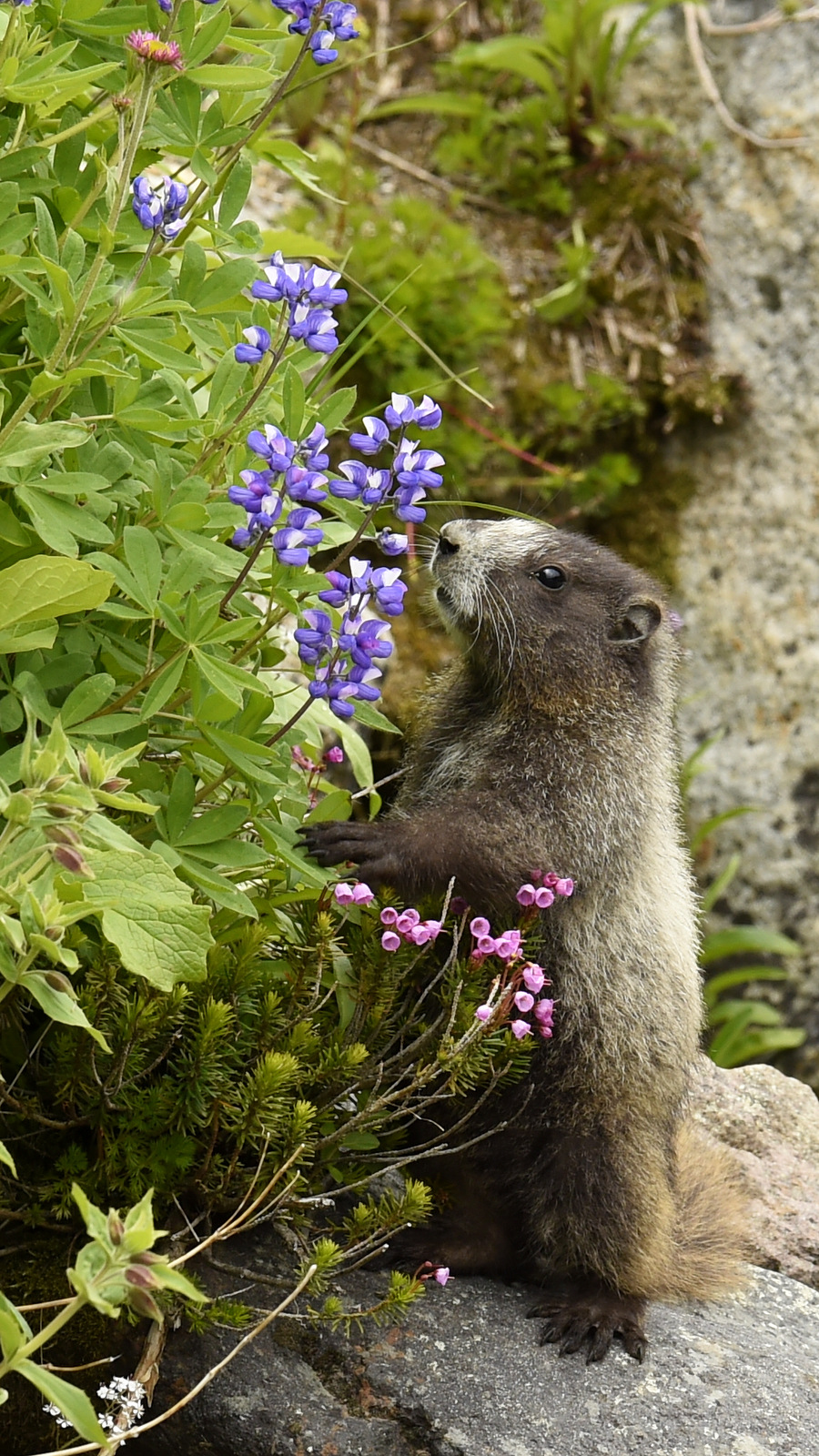 During the summer we visited Mt. Rainier several weekends in a row to try and capture the summer wildflowers at their peak. I didn’t have much luck on that front though I did get this nice shot of a marmot. And in my defense, there are 4 types of wild flowers in this scene!
During the summer we visited Mt. Rainier several weekends in a row to try and capture the summer wildflowers at their peak. I didn’t have much luck on that front though I did get this nice shot of a marmot. And in my defense, there are 4 types of wild flowers in this scene!
#3 Great Gray Owl
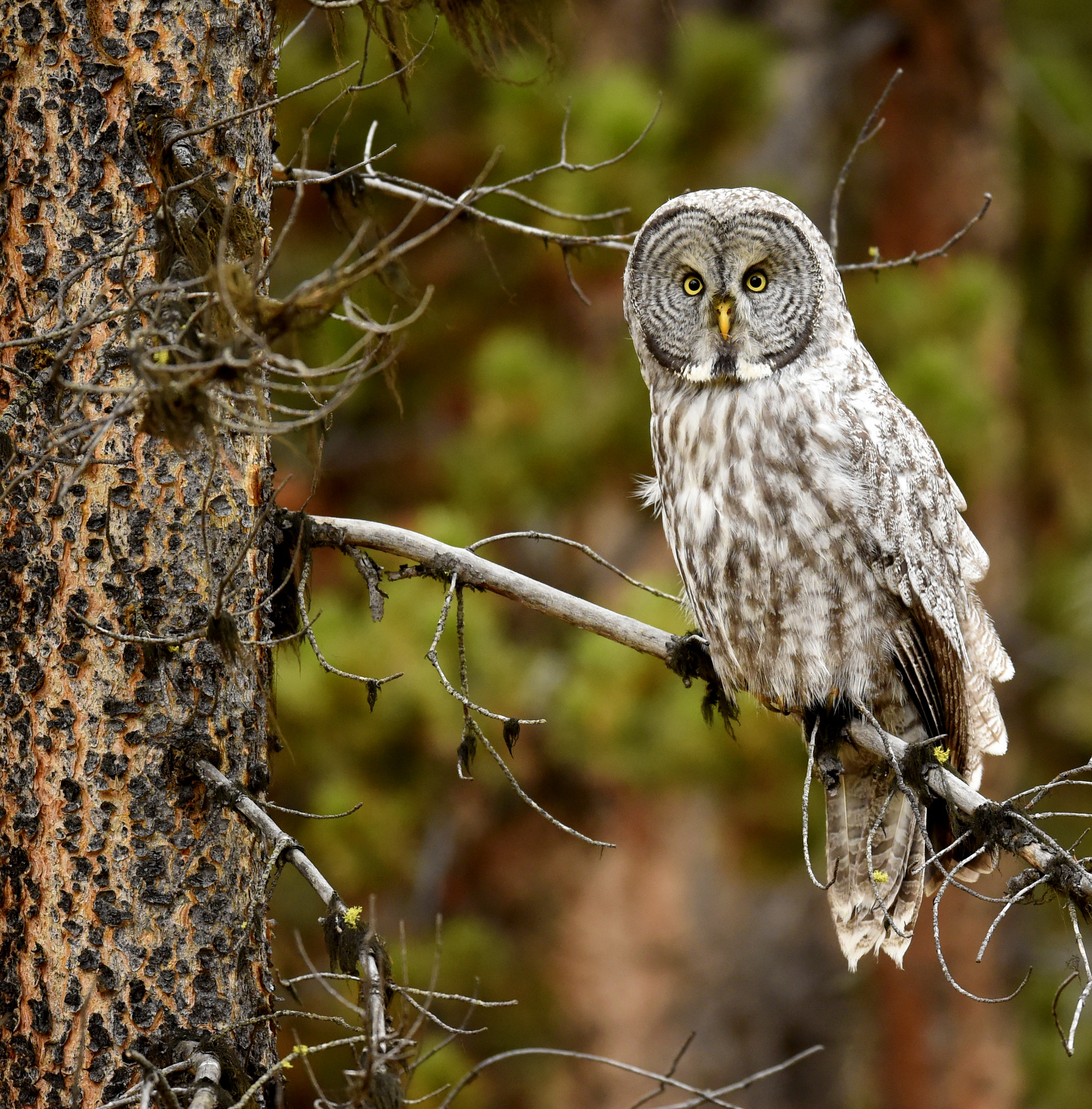 I spent three magical hours alone with this Great Gray Owl in a forest in Yellowstone NP. Wow.
I spent three magical hours alone with this Great Gray Owl in a forest in Yellowstone NP. Wow.
#4 Bighorn Sheep
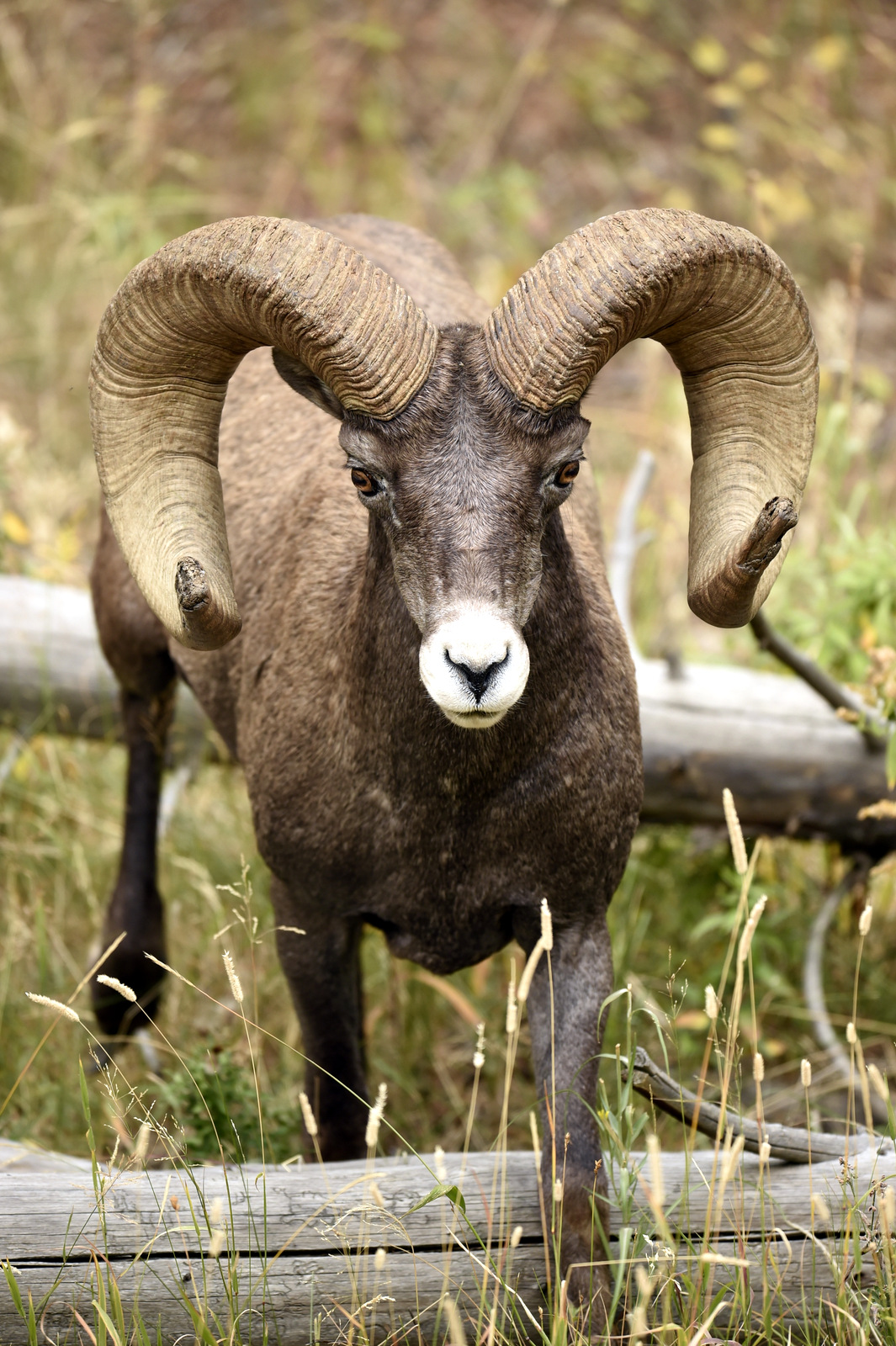 On the fall trip to Yellowstone I had my first sighting of a male Bighorn Sheep. Our guide said that this may have been the biggest ram he had ever seen during his 35 years as a guide.
On the fall trip to Yellowstone I had my first sighting of a male Bighorn Sheep. Our guide said that this may have been the biggest ram he had ever seen during his 35 years as a guide.
#5 Yellowstone Landscape
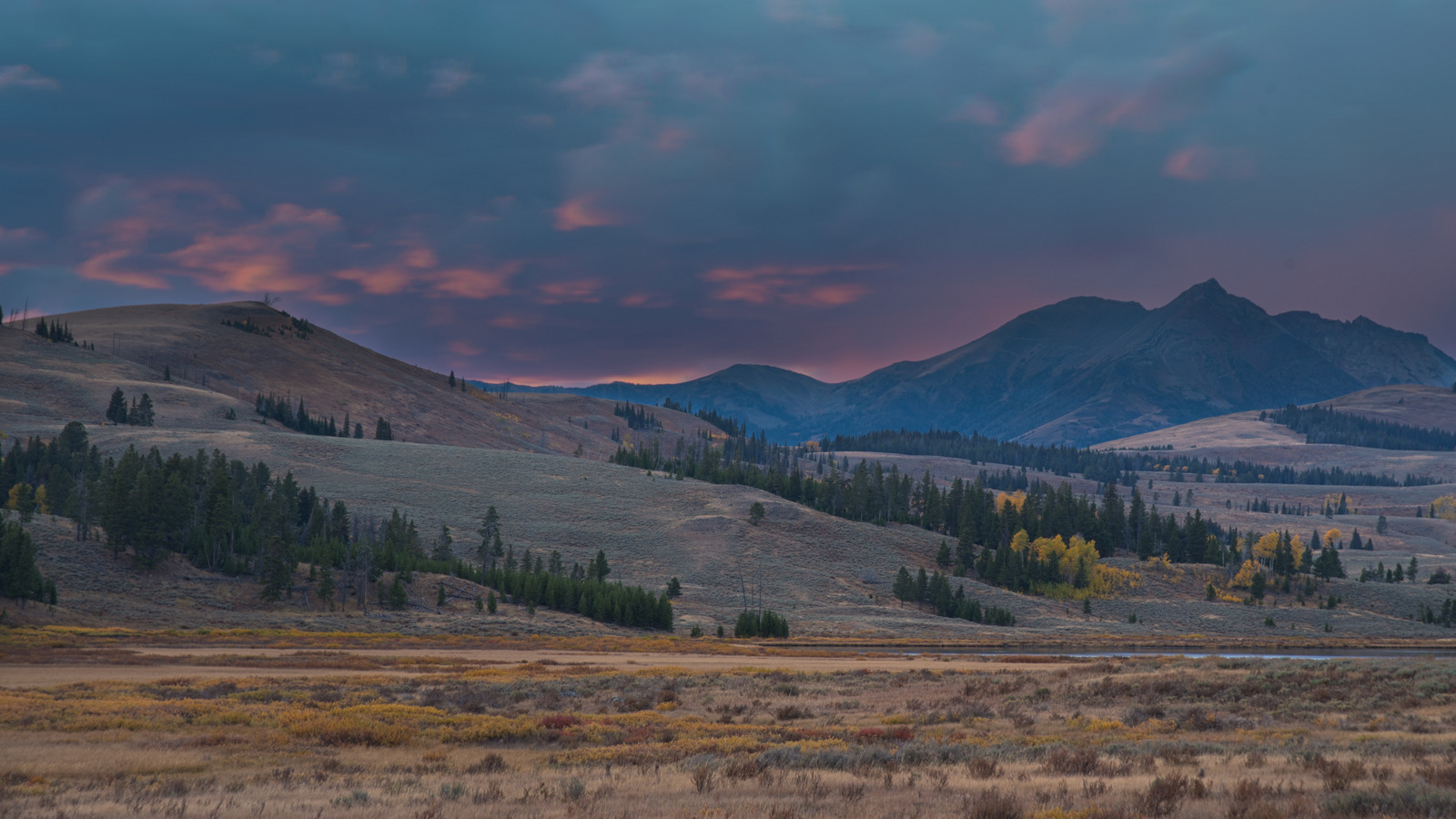 A nice sunset in Yellowstone captured using the HDR technique. If HDR is jibberish to you, learn more here.
A nice sunset in Yellowstone captured using the HDR technique. If HDR is jibberish to you, learn more here.
#6 Robin
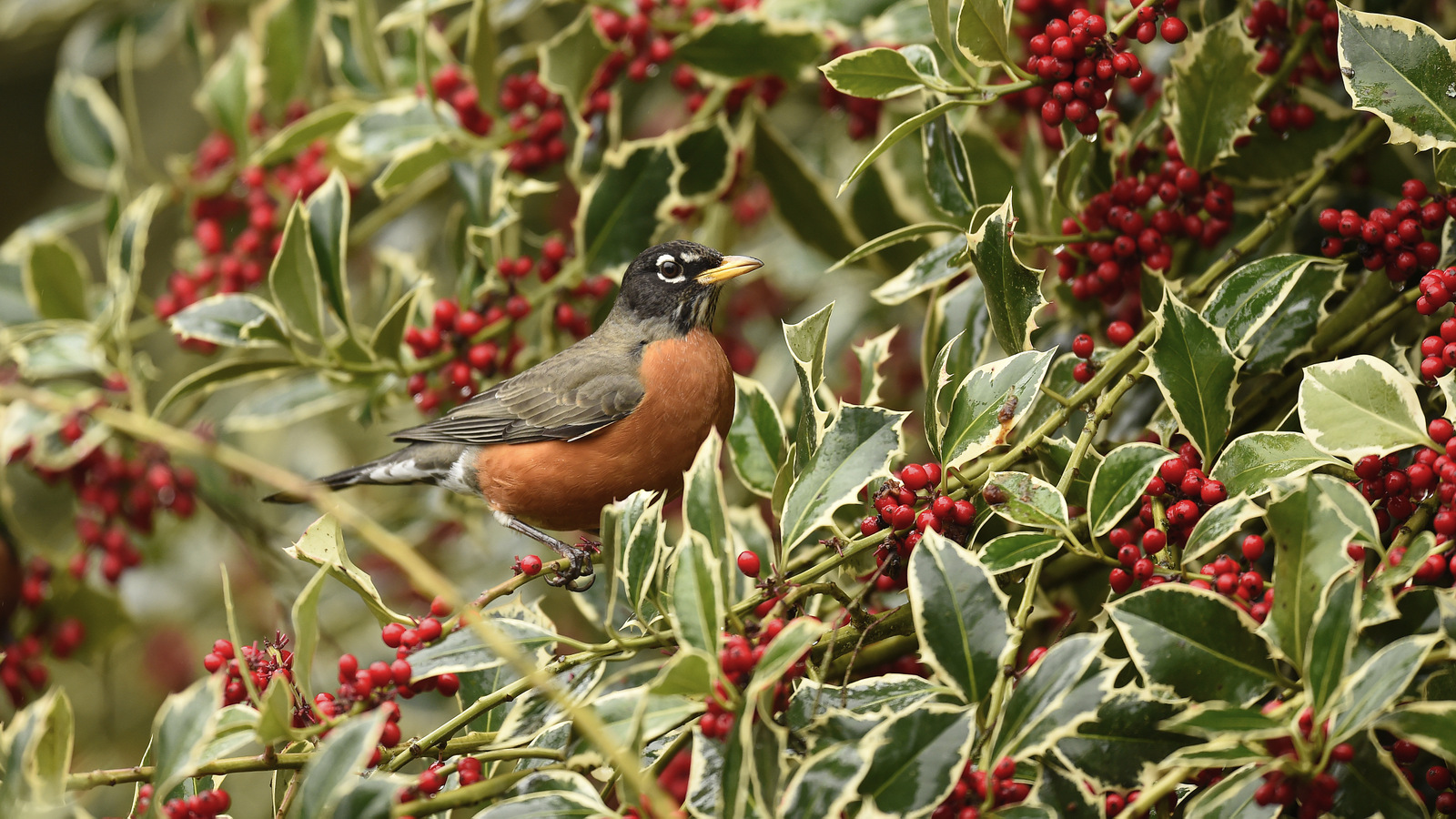 I have to admit that I never imagined that an image of a robin would make my top-of-the-year list, but I really like this scene of a robin in a holly tree. Not bad for backyard photography.
I have to admit that I never imagined that an image of a robin would make my top-of-the-year list, but I really like this scene of a robin in a holly tree. Not bad for backyard photography.
#7 Short-eared Owl
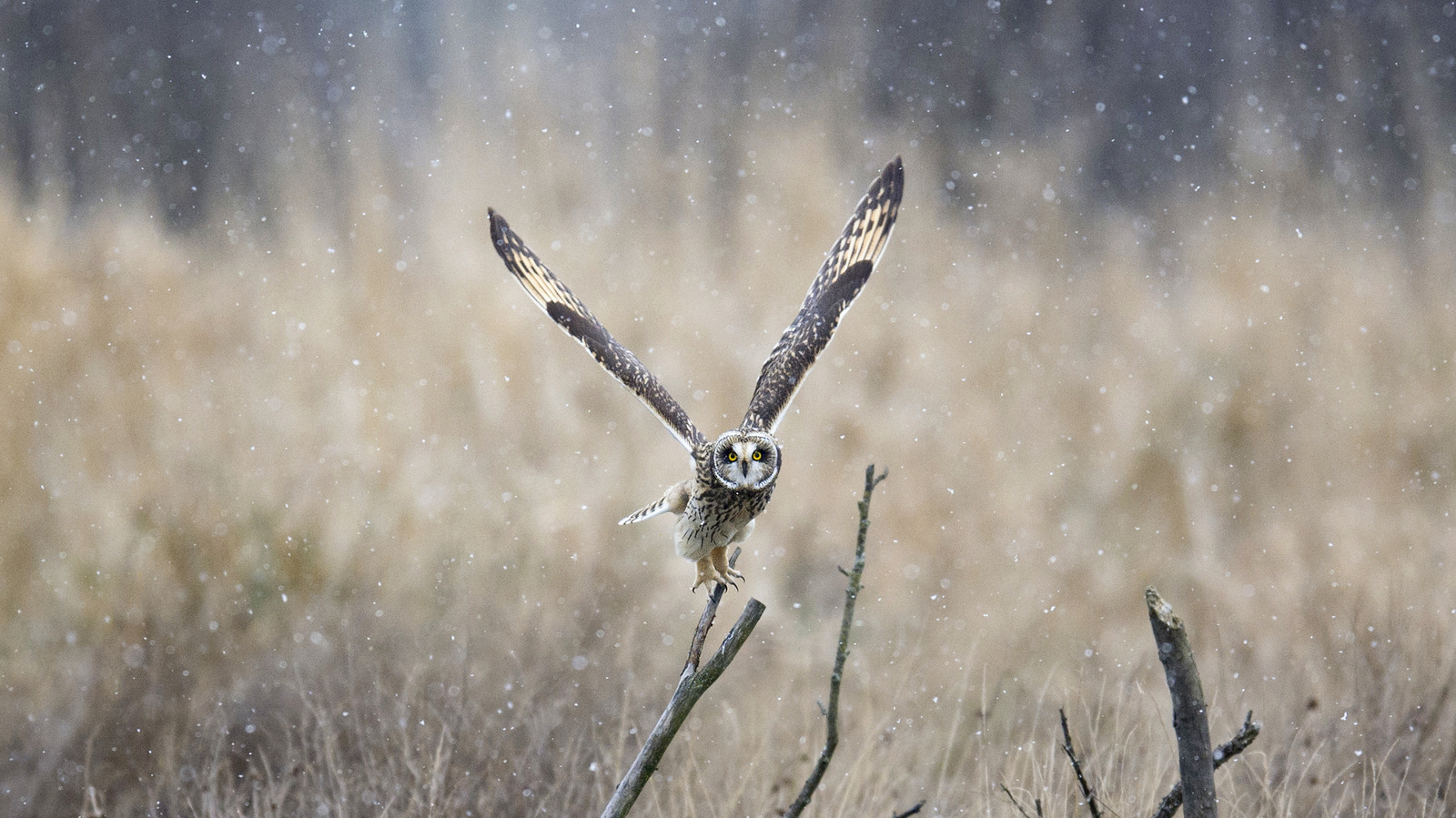 I never had much luck in finding Short-eared Owls (SEOs) on the east coast. Turns out that many owls winter over in Washington state. You now know how my winters will be spent…..This shot of an SEO taking off in the snow is my favorite capture so far.
I never had much luck in finding Short-eared Owls (SEOs) on the east coast. Turns out that many owls winter over in Washington state. You now know how my winters will be spent…..This shot of an SEO taking off in the snow is my favorite capture so far.
#8 Coyote
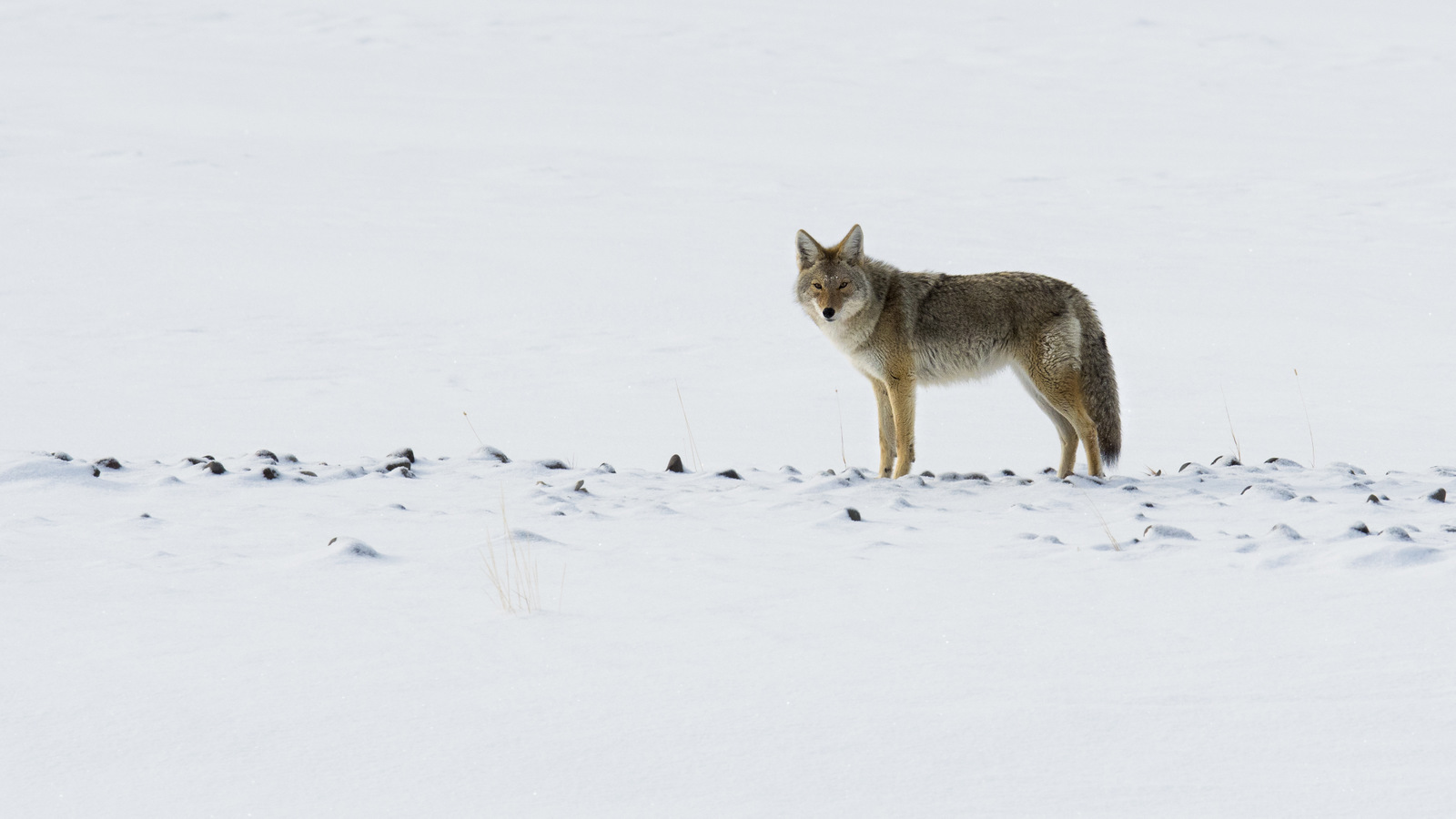 Our winter trip to Yellowstone provided my first opportunity at a decent image of a coyote.
Our winter trip to Yellowstone provided my first opportunity at a decent image of a coyote.
#9 Bison
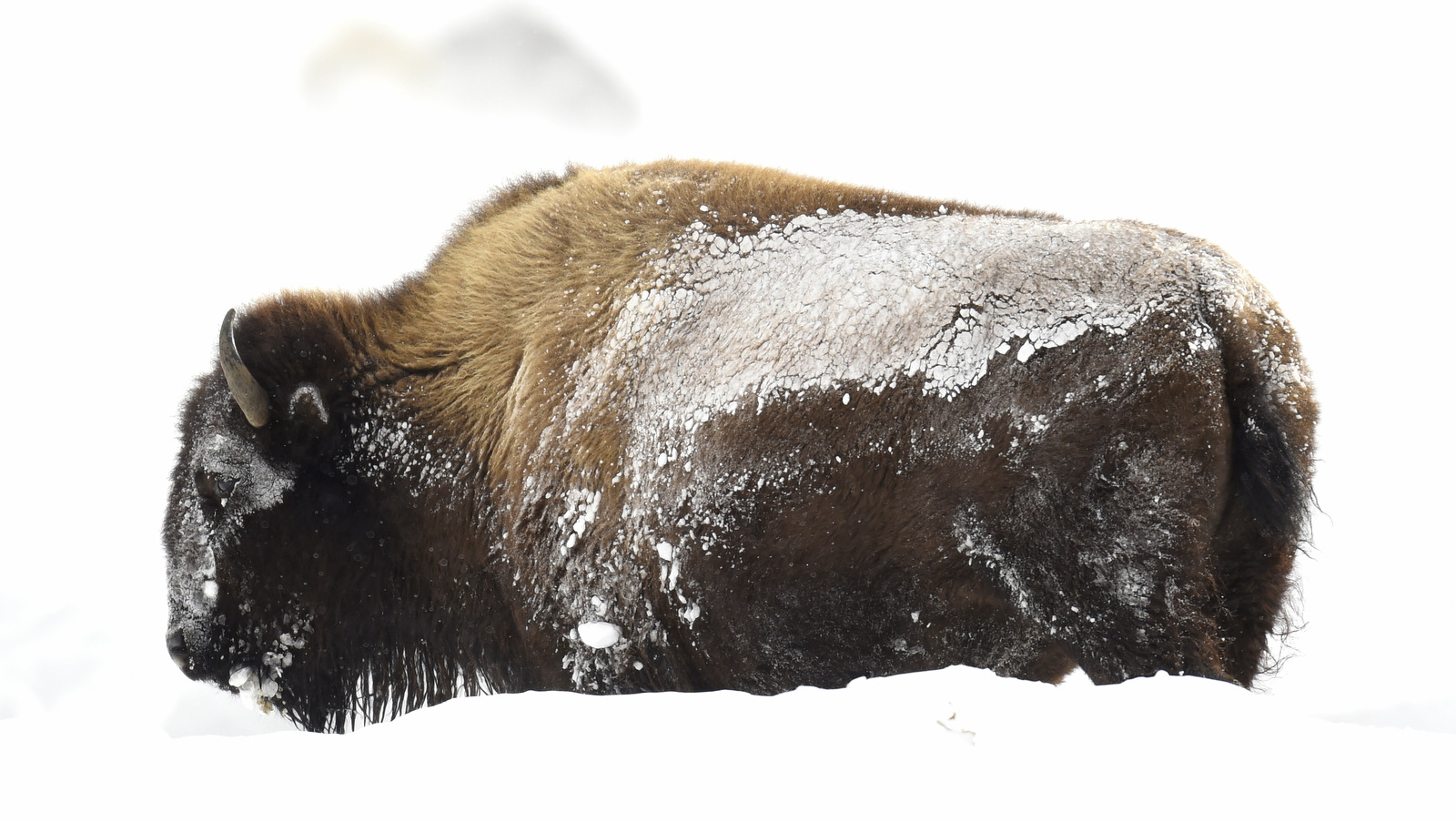 The star attraction of our winter trip to Yellowstone was the bison. I loved the abstract nature of this shot.
The star attraction of our winter trip to Yellowstone was the bison. I loved the abstract nature of this shot.
#10 Pronghorn in a snow storm
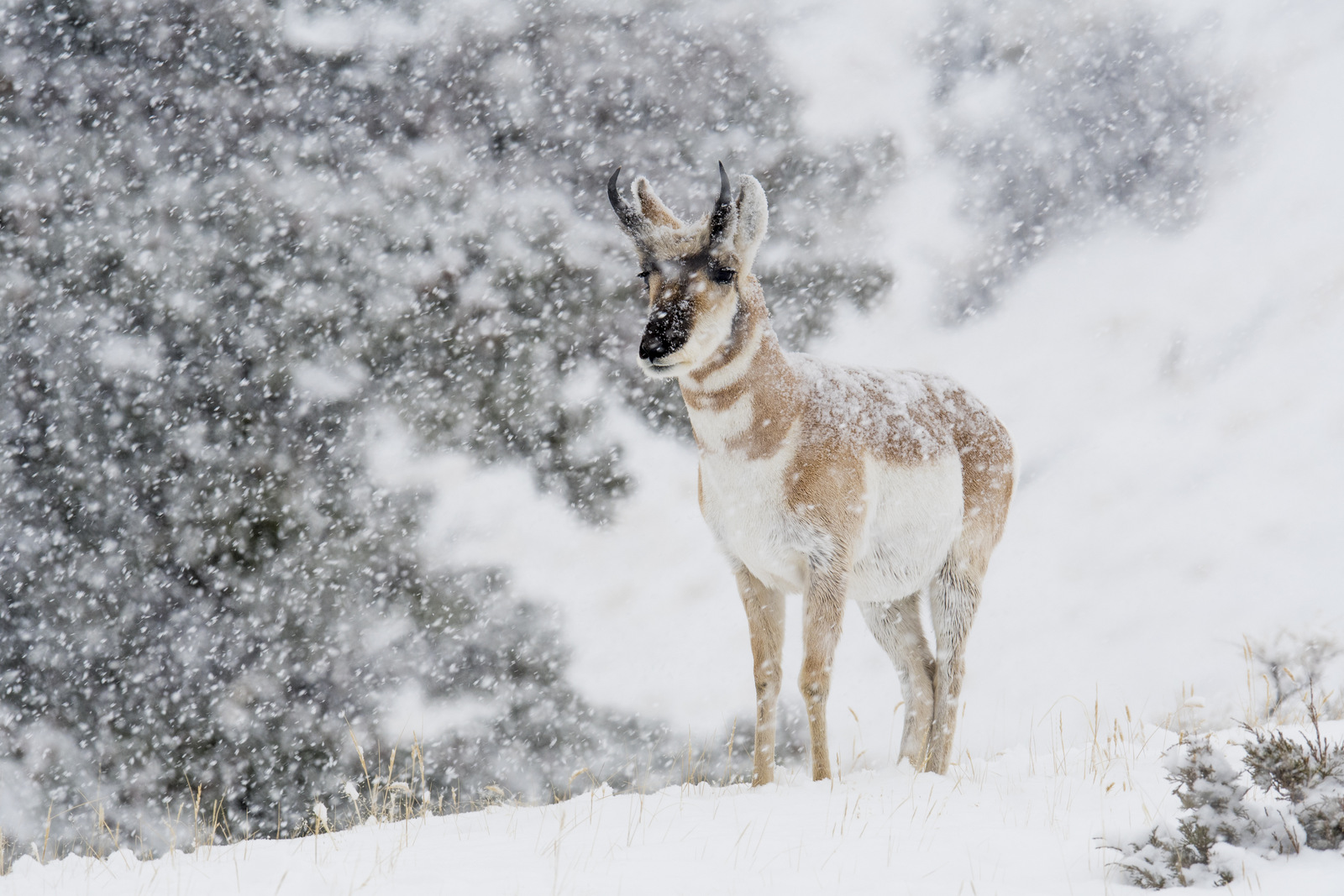 Probably my favorite shot from our winter trip to Yellowstone. One day one, five minutes from the gate at the end of the day as were leaving the park we found this herd of Pronghorn caught in a sudden flurry of snow.
Probably my favorite shot from our winter trip to Yellowstone. One day one, five minutes from the gate at the end of the day as were leaving the park we found this herd of Pronghorn caught in a sudden flurry of snow.
Wishing you a great 2017!
31
Shot of the Month – December 2016
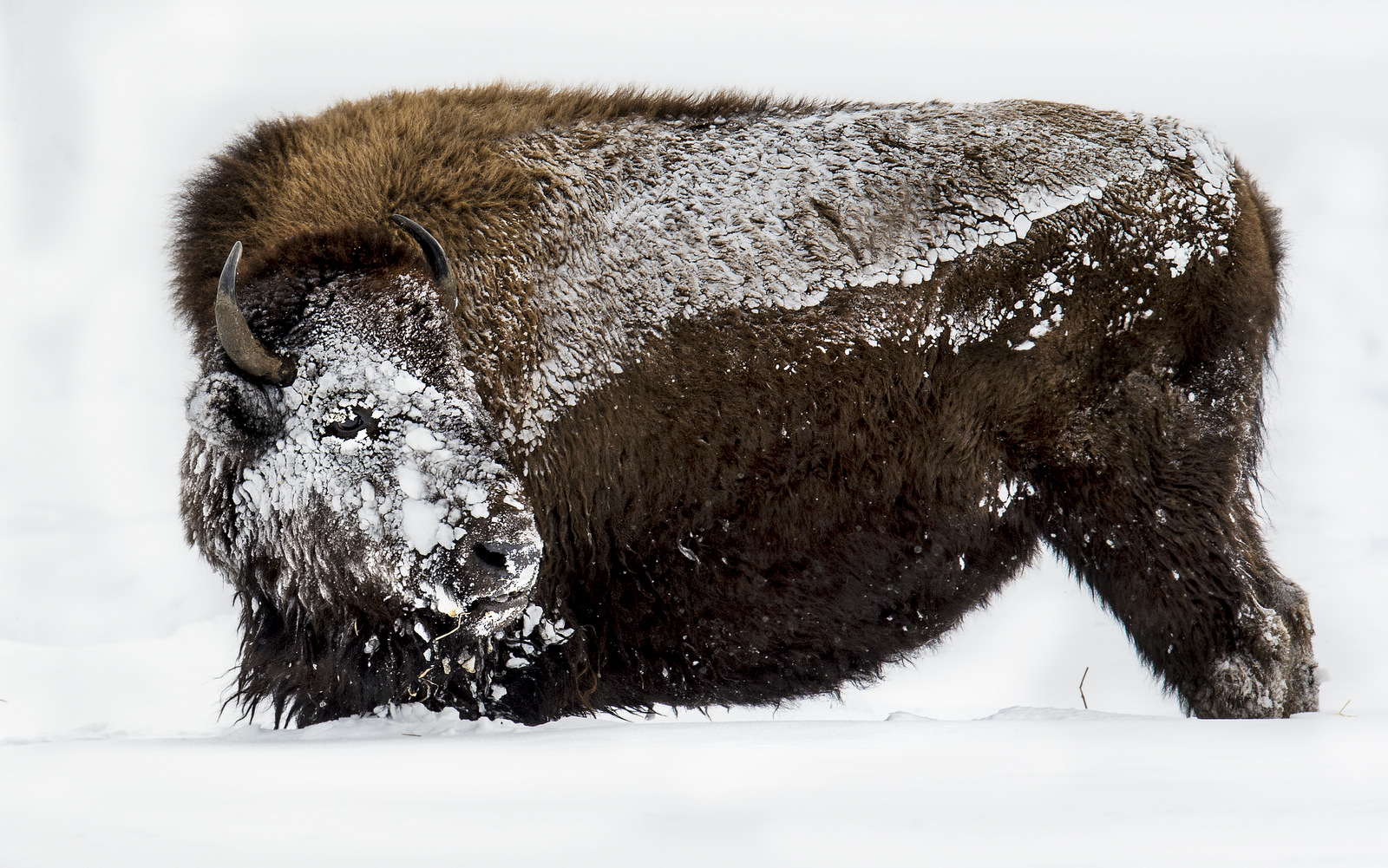 One look at this image and most of us shudder with cold in sympathy for this poor beast. Some might even clamor — “Help that poor animal, he must be freezing to death.” I am a real wimp when it comes to the cold and I normally walk around the house wearing multiple layers and a fleece — I seem to always be cold. So, upon seeing this bison in Yellowstone NP, standing in deep snow and generally covered in the white stuff, I felt quite despondent for him.
One look at this image and most of us shudder with cold in sympathy for this poor beast. Some might even clamor — “Help that poor animal, he must be freezing to death.” I am a real wimp when it comes to the cold and I normally walk around the house wearing multiple layers and a fleece — I seem to always be cold. So, upon seeing this bison in Yellowstone NP, standing in deep snow and generally covered in the white stuff, I felt quite despondent for him.
Well, dear friends, the nature science folks tell us that we can all relax. Bison have evolved over millions of years to deal with this type of weather. Our human concepts of what is cold simply don’t really apply in the bison world. When I photographed this bison I was standing in waist-deep snow and it was about 16° Fahrenheit. There was also a gusty wind that would swirl about causing mini blizzards every few minutes such that I would lose sight of this massive beast for a few seconds at a time. In Yellowstone, a temperature of 16° F is considered “moderate” — almost balmy conditions considering that temperatures can easily drop down to -30° F and beyond.
I have been told by park officials that bison don’t feel the cold until it reaches about -40° F. Nope, not a typo. In the winter a bison will grow a coat of woolly underfur with coarse guard hairs that protects them from the elements. This rich coat has 8 times the number of hair follicles compared to cattle. The fur is thickest on the bison’s head, on the front of their body and on their forelegs. When the wind blows us humans will often turn our backs to the wind to avoid the worst of it. Bison have no need for such contortions; given their full fur defense they are quite content to face directly into the onslaught. The bison swings its massive head into the snow to clear the way so that it can eat the grass that lies beneath — the body is so well insulated that the snow does not melt as you can see in this photo.
So, now you know, the next time you see what looks like a poor, freezing bison, you can rest assured that he is most likely doing just fine and is rather, just chillin.
Until next month….michael
🙂
Nikon D4S, Nikon 600mm, 1.4 x TC (effective 850mm), f/9, 1/640 s, +1 EV, ISO 500
30
Shot of the Month – November 2016
For someone who doesn’t believe in climate change then karma would dictate that said person be reincarnated as a Pika. But before we get to the hot topic at hand, what the heck is a Pika you might ask. I think Pika is an acronym for Probably the most Incredibly Kute Animal. Though, I might be wrong on that.
The Pika is an incredibly cuddly and cute fur ball found amongst the highest mountain ecosystems around the world. “Fur ball” is pretty accurate as a Pika’s body is quite round and she doesn’t have a tail. There are about 30 species of Pika in the world (mainly Asia, North America, and parts of Eastern Europe) with one species found in the United States. The American Pika can be found in Colorado, Oregon, Washington, Idaho, Montana, Wyoming, Nevada, California, and New Mexico. The fine lass (could be a chap, I have no way of knowing) above was photographed in Yellowstone NP.
The Pika is well adapted to surviving in alpine mountain ecosystems which are typically windswept, treeless, and frigid. The alpine zone only represents about 5 percent of the planet’s surface and thanks to climate change, this habitat is disappearing fast. As the mountain tops warm the vegetation changes, the snowpack melts and new predators and pests move in. Most mountain habitats in the Western US have warmed by at least 1 degree F in the last hundred years. In the next hundred years, the temperatures are expected to rise by another 4.5 to 14 degrees.
Pikas literally cannot take the heat. Expose a Pika to temperatures above 78 degrees and she will die within six hours. Yes, really.
In Oregon and Nevada Pikas have disappeared from 1/3 of their previously known habitat. Since the early 1900’s the Pika has disappeared from 8 of the 25 U.S. mountain ranges where they previously lived. Pikas keep climbing higher but once they reach the top of the mountains, they can’t go any higher to escape the deadly heat.
Expect to see the Pika on the Endangered Species list soon. And given current trends, the Pika may become the first known species in the US to go extinct from climate change.
As they say, karma is a b****.
Until next month….m
Nikon D4S, Nikon 600mm w 1.4x TC (@ 850mm), 1/750s, f/5.6, ISO 720
31
Shot of the Month – October 2016
Last month’s image was a cacophony of color amongst the trees. This month’s image captures the quiet stillness of shades of gray by the waters edge. I love how the image transitions from pure white in the upper left corner through shades of gray to deep black in the lower right corner of the image. On this sunless morning in Vermont the lake was quiet and there was no wildlife to be found. While drifting along in my kayak, with not much to do, I came upon this spider’s web and decided to experiment and see what I could come up with. While shooting this image my main focus was on trying to capture the glistening dew drops on the spider’s lair. I paddled around and around trying every position imaginable until I found the angle that worked best. The image was shot with a point-and-shoot camera (Canon G1X).
Converting the photo to black and white was rather easy given that there was virtually no color to be found in the scene. Other than the two corners, most of the image is filled with shades of gray.
Turns out that creating gray can be a rather complicated affair. In the art world painters create different shades of gray by mixing black and white paint in different proportions. Want a darker gray? Add more black. Lighter gray? Add more white. You get the idea. A mixture of just black and white creates a “neutral gray.” Add a bit of yellow, orange or red and you can add a warm cast and create a “warm gray.” Add a bit of green, blue, or violet and you can get a “cool gray.”
In the world of print the CMYK color model is used — cyan, magenta, yellow, and black. All colors are made from a combination of these four colors. To make gray you add equal amounts of cyan, magenta and yellow.
TV and computer screens use a RGB color model – red, green and blue. Red, green and blue light at full intensity on the black screen makes white; by lowering the intensity one can create shades of gray.
On this particular day mother nature made graduations of gray by blocking out the sun with a heavy shroud of fog with a dab of dew thrown in for good measure.
I have to say, I am a big fan of her work……
Until next month…
Canon Powershot G1 X, @ 17.2 mm, f/5.6, 1/60 s, ISO 200,

